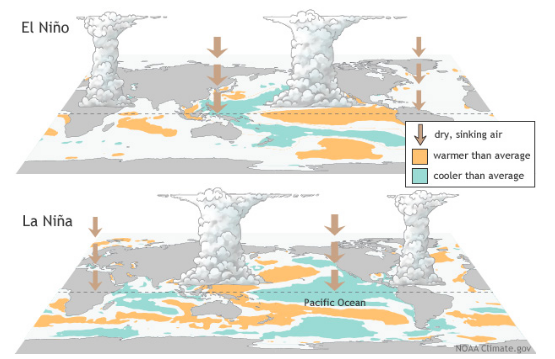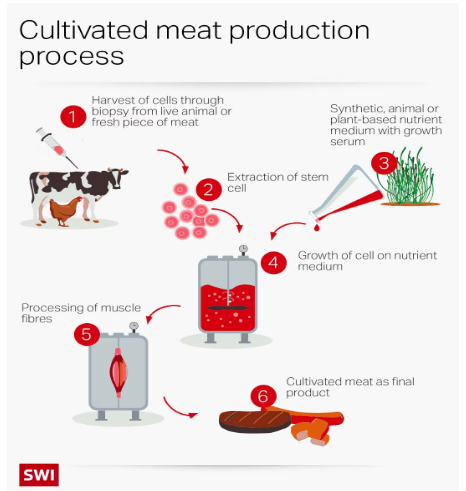Context:
The development of a positive Indian Ocean Dipole (IOD) has led to optimistic expectations regarding its ability to counterbalance the El Nino effect.
About El Nino:

Image Credits: NOAA Climate.gov
La Nina:
El Nino Southern Oscillation (ENSO):
Indian Ocean Dipole (IOD):
Relation between IOD and El Niño:
Impact of IOD:
News Source: The Indian Express
Context:
The on-ground assessment of cleanliness of cities as a part of the Swachh Survekshan 2023 began on Monday.
About Swachh Survekshan:
Swachh Survekshan 2022 Rankings:
| Additional Information:
About Swachh Bharat Mission:
|
News Source: Indian Express
Context:
India has ranked 40th on the latest world competitiveness ranking released by the International Institute for Management Development (IMD).
About Global Competitiveness Index:
India’s Ranking:
Global Rankings:
News Source: money control
Context:
The Ministry of Ports, Shipping & Waterways launched ‘Sagar Samajik Sahyog’ – the new guidelines of Corporate Social Responsibility (CSR).
About the News Guidelines:
| Additional Information
About Corporate Social Responsibility:
|
News Source: pib
Context:
The Indian Army’s Spear Corps accused women activists in Manipur of obstructing routes and interfering in security operations amid ongoing rioting and unrest in the state.
About Meira Paibis of Manipur:
What social role do the Meira Paibis play?
News Source: Indian Express
Context:
The Ministry of Micro, Small and Medium Enterprises (MSME) launched the Champions 2.0 Portal and accompanying mobile application on 27 June, the International MSME Day.
About Champions 2.0 Portal:
Other initiative launched:
| Additional Information:
About Champions Portal:
|
News Source: livemint
Context:
United Nations has appointed Indian-origin satellite expert Aarti Holla-Maini as the Director of the United Nations Office for Outer Space Affairs.
About United Nations Office for Outer Space Affairs:
News Source: livemint
Context:
President conferred Distinguished Service Awards, including 52 Ati Vishisht Seva Medals, on 84 serving and retired personnel of the armed forces and the Indian Coast Guard.
About the Awards:
News Source: The Hindu
Context:
Recently, two California-based companies were cleared to make and sell their cell-cultivated chicken in the USA.

Image Source: swissinfo
About Cell-Cultivated Chicken:
Challenges:
Arguments in favour of developing Lab-grown meat:
News Source: The Hindu
Context:
IDFC First Bank said it had raised ₹1,500 crore of Tier2 bonds in the domestic bond market.
About Tier-2 Bonds:
Benefits of Tier-2 bonds:
Risks:
What Is Tier 2 Capital?
| Additional Information:
About Bonds:
Additional-Tier- 1 Bonds:
|
News Source: The Hindu
Context:
Recently, the Geographical Indications Registry in Chennai has given tags to seven different products from Uttar Pradesh.
| Probable Question:
Q. What are some of the challenges faced in implementing and managing the Geographical Indication (GI) tag system in India? |
More on News:
About Geographical Indication Tag:

Image Credits: Times of India
Process Governing GI Tag:
| Note: A GI registry has been set up under the Controller General of Patents, Designs, and Trade Marks to administer the GI of Goods (Registration and Protection) Act, 1999, which protects the GI of goods. |
Methods to Protect a Geographical Indication:
Benefits of GI Tag:
Challenges Associated with GI Tag:
Initiatives taken by Government to Promote the GI Tag Products:
Way Forward:
News Source: The Hindu
SC Verdict on Newsclick Shows Adherence to Due Pro...
Stay Invested: On Chabahar and India-Iran Relation...
Credit Rating Agencies, Impact on India’s De...
Catapulting Indian Biopharma Industry
Globalisation Under Threat, US Import Tariffs Have...
Global Report on Hypertension, Global Insights and...
<div class="new-fform">
</div>
